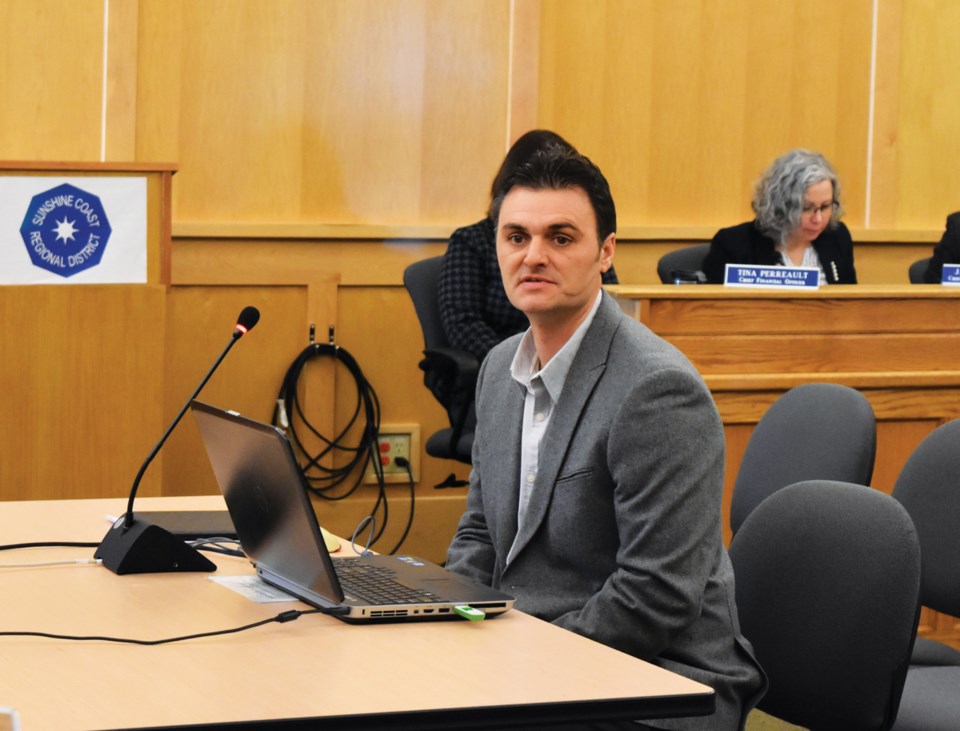“Collaborative, transparent, thorough, professional and scientific” is how a Burnco representative described the environmental assessment process for its proposed McNab Creek mine to a Sunshine Coast Regional District (SCRD) committee on Feb. 22.
Derek Holmes, land and resource manager, gave a presentation in response to a letter sent by the SCRD to the Canadian Environmental Assessment Agency (CEAA) and BC Environmental Assessment Agency, that criticized the lack of public input and what’s known as the professional reliance model. He detailed the company’s environmental review process and public and stakeholder outreach.
“We started by asking questions before studies were even conducted,” Holmes said. “Nothing was hidden.”
Holmes defended the public consultation process by outlining its scope. “There were three written comment periods provincially, three written comment periods federally, with every single one of those comments answered by Burnco and vetted by all of the agencies and the working group.” He also said Burnco held multiple open houses with Indigenous groups.
Holmes said Burnco will develop a community advisory group and that the company has developed a “community enhancement fund,” that takes money from every ton of aggregate removed and puts it back to the community. In addition, he said Burnco has a website devoted to the project and environmental management plans spanning the lifetime of the project, including the reclamation period once the mine is closed.
Ian Winn, director of West Howe Sound, said he appreciated hearing the other side of the story, and commended the amount of information made available, but that ironically, the “overwhelming” number of studies made it harder for the public and stakeholder groups to digest. “They didn’t have the ability to hire their own engineering firms to study the volumes and volumes of three-inch binders of information.” He added that while he has heard from hundreds of people, “probably less than 10” are in favour of the project.
“I agree that the binders were ridiculously huge but they are summarized quite succinctly in about 30 pages,” said Holmes in response.
Mark Lebbell, director for Roberts Creek, raised concerns about the way the province conducts environmental assessments. “The facts that the province is reviewing its professional reliance approach right now and the federal government is also looking at its EA process, I think are indicative that the process concerns are not just ones that come from this community and this project.”
Holmes said as well as hiring consultants to develop plans, the civil service also reviewed them, and the Squamish Nation – which is in favour of the project – hired a third-party environmental consultant to review the process. These measures, he concluded, ensure “we’re not paying for results, that the results are valid and the conclusions can stand the test of time.”
Shíshálh Nation director Keith Julius used Lehigh Materials in Sechelt as an example of what can go wrong despite thorough public consultation and environmental assessment processes. “I recall them coming before us and sitting down there just like you are, and going through everything that you just went through, promising us all these things,” he said.
Despite those promises, Julius said, hydraulic and oil leaks happened and Lehigh did not respond adequately to these accidents. “I hope it’s going to be the opposite and things will be acted upon.”
Garry Nohr, director for Halfmoon Bay, was more positive, giving Holmes “full marks” for addressing the committee. He said he spoke to mayors in Alberta municipalities that worked with Burnco. “I would suggest you made a mistake by not bringing them out here and letting them talk to the communities here… they admitted you were accommodating and helped the communities.”
Burnco has been working to have the project approved for six years. The CEAA found that the mine is not likely to cause significant environmental effects.



